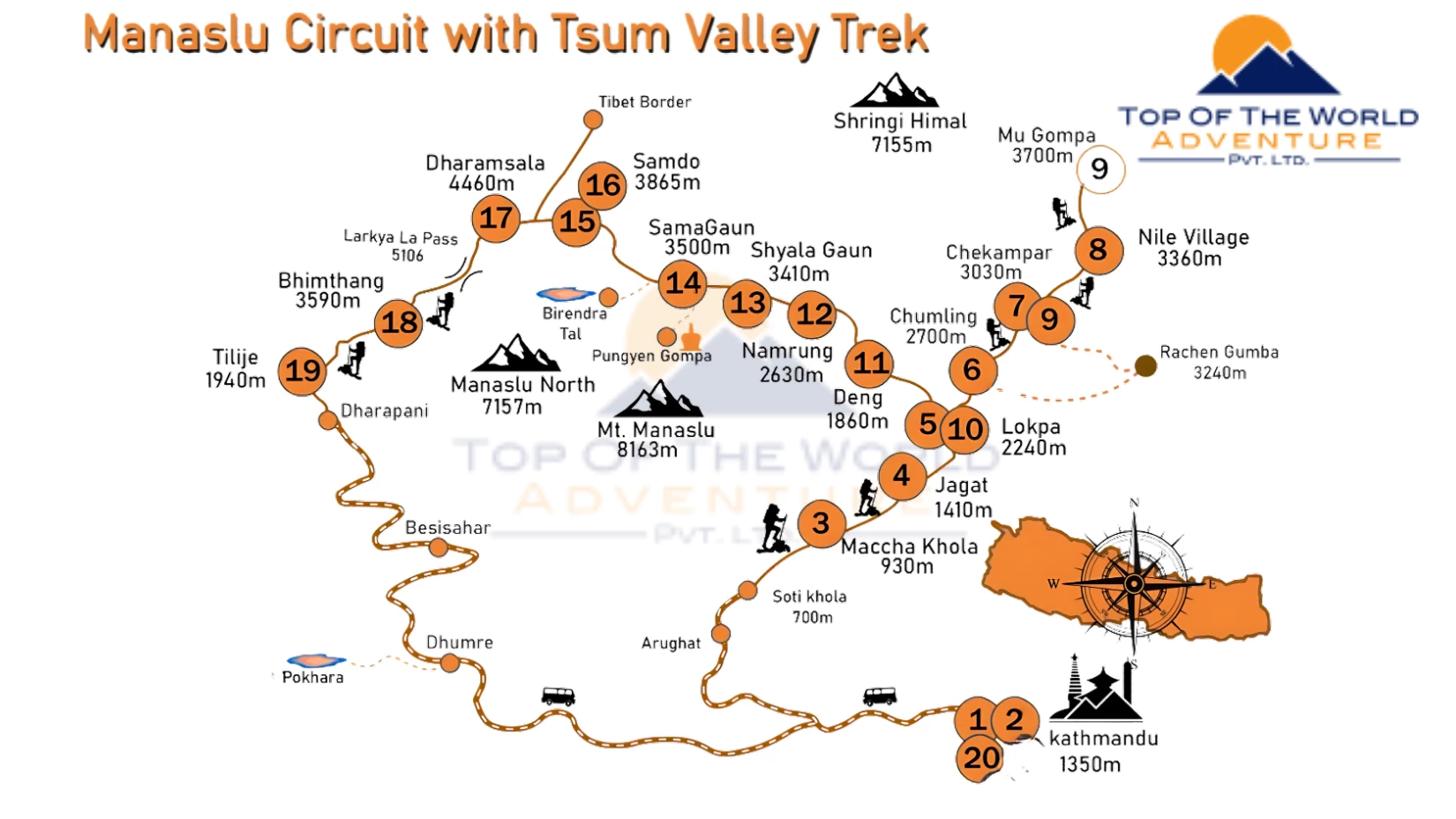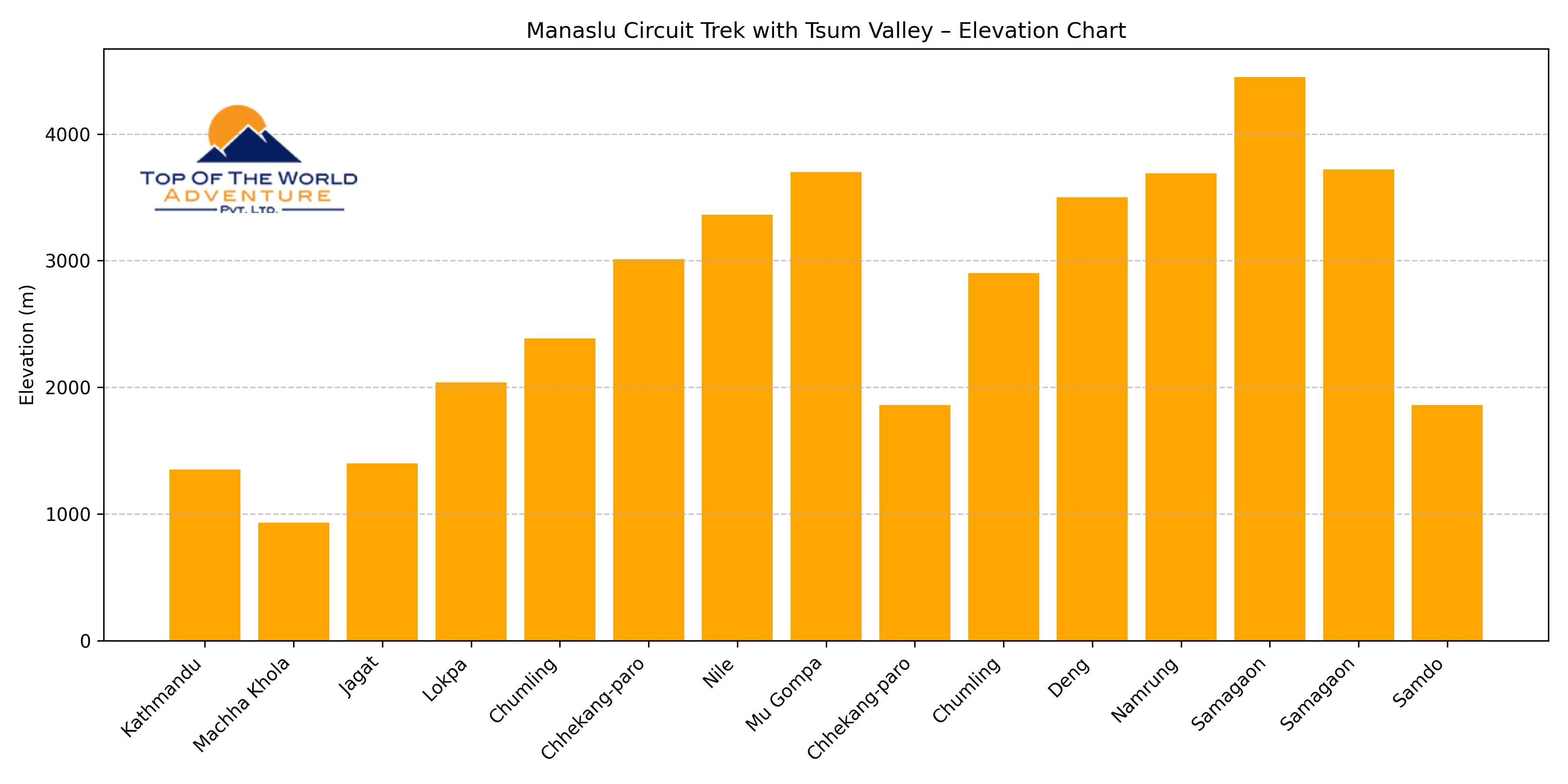The Manaslu Circuit trek encircles Mount Manaslu, the eighth-highest mountain on Earth. It is an exclusive and restricted area trek in Nepal that was closed to foreigners until the early 1990s. Even after that, the region remains an untouched gem and is now considered one of the best trekking destinations for adventure treks in Nepal.
Highlights
- An exclusive and restricted area trek in Nepal that takes you close to Nepal Tibet border
- Embark on an adventurous journey and explore a corner of the Himalayas where only a few make their way
- Offbeat terrain, striking mountain views, and breathtaking landscapes
- Enjoy less crowded trails, walking through peaceful terraces and forested hills, and beautiful villages
- Push your limits as you ascend the Budhi Gandaki Gorge and conquer the challenging Larkya La Pass
- Experience a unique mountain lifestyle and get to know Nepali communities like Gurung, Magar, and Nubri
- Discover the unique flora and fauna of the Manaslu Conservation Area
- Cross thrilling suspension bridges and relish the beauty of cascading waterfalls, streams, and rivers
- Explore Manaslu Base Camp, Birendra Lake, and Pun Gyen Gompa
You might have heard about the Annapurna Circuit or Everest Base Camp trek. These are the two most popular trekking programs in Nepal, as well as the most busy and commercialized ones.
The Manaslu Circuit trek offers way less crowded trails and pristine beauty. The journey is quite raw and challenging. Trekkers searching for something different, adventurous, and daring will love it.Not only that, but you will also enjoy striking mountain vistas and jaw-dropping scenery throughout the journey. In addition to that, experience a simple Himalayan lifestyle and meet with Nepali communities like Gurung, Magar, Nubri, etc.The grandeur of the Manaslu region will leave you in awe. Every day will hold new challenges and experiences. This trek has never-ending adventures and ample time to unwind and enjoy nature.
Bookings are open for Manaslu Circuit trek 2025 and 2026 departures!
What can you expect during the Manaslu Circuit trek in Nepal?
The Manaslu Circuit trek route is inside the Manaslu Conservation Area. From Kathmandu to the starting point of the trek and up to the Larkya La Pass, you will traverse different climatic zones and discover diverse flora and fauna.
Please check our Manaslu Circuit trek map below to have an overall view of the route.
The trek starts from Soti Khola and ends in Dharapani. The trip is 15 days long but you can also combine a side hike to the hidden Tsum Valley in your itinerary, which will extend the trek to 21 or 22 days.
During the trek, you can see Mount Annapurna dominating the western side of the sky and Ganesh Himal to the east. Mount Manaslu itself is visible from many parts of the trail. Likewise, you will also see views of Simnang Himal, Shringi Himal, Naike Peak, Boudha Himal, etc.It is an off-the-beaten trek. The trail passes through hot lowlands with rice and millet terraces and lush hills to the mighty gorges of Budi Gandaki. The terrain involves many steep and rocky ascends and descends.You will also experience daily altitude gain and the remoteness of the region. Therefore, trekkers must be physically and mentally fit to enjoy the Manaslu Circuit trek.
The trail is connected by many suspension bridges, but you will also cross a few wooden bridges and semi-submerged rocks. Likewise, enjoy cascading waterfalls, streams, and rivers and relish the changing colors of the hills along the trail.In Sama Gaon, we will take an acclimatization break and use this opportunity to explore the Manaslu Base Camp, Birendra Lake, and Pun Gyen Gompa. All these three places are accessible from Sama Gaon in 2 to 3 hours of hiking.Then comes Samdo village, which is also a Tibetan refugee village. From here, you can hike to Rui La Pass, once used as a trade route between Tibet. After Samdo, you will spend a night at Larkya Phedi, also known as Dharamsala, and ascend to the Larkya La Pass.Crossing this pass is challenging and involves almost 8 to 9 hours of walking that day. It will be one of the unforgettable days of your trek. Depending on the weather and trail conditions, you may need micro crampons while descending to Bimthang.From the top of the pass, you will behold the most incredible landscape of your life. As you leave the pass and walk along the west corridor, you will see a great glacial cirque and spectacular stream of glaciers created by Himlung Himal, Cheo Himal, Kang Guru, and Gyajin Kang wall.
This view alone will make all the hardships of the Manaslu Circuit trekking worthwhile.
Cultural engagement during the trek and offbeat trails
The Manaslu Circuit trek is adventurous and culturally fascinating. It passes through beautiful villages inhabited by different Nepali communities. Our guide will help you understand the daily life of the locals and their traditions.You will have memorable interactions with them. The trail is dotted with many stupas and chortens. Pun Gyen Gompa is one of the significant monasteries on the Manaslu Circuit trail that you will visit during your acclimatization day in Sama Gaon.Likewise, the offbeat trails are a bit tricky to navigate and require previous experience. You will climb up and down from many steep hills and gorges. Similarly, cross a few landslide-prone areas on the way and walk through glacier moraine at upper altitude.
Why is Manaslu Circuit a restricted area? What does it imply for foreigners?
The Manaslu region is one of the restricted areas in Nepal because it shares a border with Tibet. To maintain border security and protect and preserve the rich biodiversity, the Nepal government has made this region a restricted area for foreigners.Now, interested trekkers have to obtain special restricted area permits to trek or climb in the Manaslu region. Likewise, they have to follow strict rules, like mandatory trekking with a licensed Nepali guide in a group of at least two trekkers.
You can not hire an independent guide to do the Manaslu Circuit trek. Trekking with a local agency like us is necessary.
Is Manaslu Circuit trek 15 days suitable for you?
Trekkers have to consider a handful of things before joining the Manaslu Circuit trek 15 days, including their physical and mental fitness, budget, trek duration, time of the year, and overall trek expectations.The challenges of the Manaslu Circuit trek demand strong fitness and previous high-altitude experience. On average, six hours of walking are required. Trekkers also have to adjust to simple tea houses and limited services.
*Note that the Manaslu Circuit trek distance is approximately 180 kilometers.
It will be a life-changing odyssey, but at the cost of your efforts. If you are ready to go beyond your limit and explore the less-trodden realms of the Himalayas, this trek is suitable for you.
Who will be your guide and porter during the trek?
You will do the Manaslu Circuit trek with a local Nepali guide who has led many trekkers before. We will provide a friendly and professional guide. He will enrich the journey with his knowledge and expertise.
Our guides are trained to provide first aid, so if you get hurt or sick, they will help you. You do not have to worry about anything. Likewise, our guide will also make the journey fun. You will laugh, sing, and dance a lot.Porters carry the duffle bags for the trekkers. Each trekker can pack up to 9 kg in a duffel bag and 5 kg in a daypack. Trekkers are recommended to pack things that they may need to use while walking, such as water bottles, snacks, documents, cash, sunglasses, SPF, etc, in their daypack.
*Note: Tipping guides and porters is a common practice in Nepal and is expected at the end of their services. If you are happy with their help, we highly recommend tipping them. You can tip as much as you wish.
Manaslu Circuit trek preparation and packing
Preparing and packing for the Manaslu Circuit trek is a crucial factor that determines your overall experience. You have to be physically and mentally ready for the trip and well-packed.Physical preparation includes improving your strength and stamina so that you can walk long hours daily on rugged terrain. Likewise, mental preparation involves understanding the region and its remoteness, which will help set the right expectations for the journey.
Finally, you also need to carry proper trekking clothes, gear, and other essentials. Below, we have made a list of things that you will need during the Manaslu Circuit trek:
- Comfortable, breathable underwear
- Base layer and thermal layer
- Trekking t-shirts and pants
- Down jacket
- Fleece jacket
- Windproof/waterproof jacket and pant
- Thermal socks, gloves, beanie, and scarf
- Dry towel
- Hiking socks
- Trekking boots and a causal pair of shoes/slippers
- Duffel bag and day pack
- Trekking poles, UV ray protection sunglass, sun hat, sleeping bag and liner
- Reusable water bottles and water purification tablets
- Portable torch, knife, map
- Personal first aid kit (bandaids, insect repellant, ointment, hand sanitizer, crack bandage, pain relief gel/spray, general medicine, etc)
- Toiletries (deodorant, SPF, lip balm, toilet paper, wet tissues, moisturizer, comb, toothpaste/brush, soap, etc)
- Snacks, nuts, energy bars, ORS (electrolyte powder)
- Cash, travel insurance documents, passport-size photo, valid passport, travel visa
Safety and comfort with Top of The World Adventure team
When it comes to trekking in the remotest sections of the Himalayas, where only a few make their way, you need a strong local crew to support you during the voyage.
We, the Top Of The World Adventure team with more than 10 years of expertise, assure you of a hassle-free, comfortable, and safe Manaslu Circuit trek. Our Manaslu Circuit trek itinerary is tested to provide ample acclimatization opportunities and time with locals.We arrange every aspect of the trek and help you obtain the restricted area permits seamlessly. Our network with the locals along the trail allows you to have the best tea house experience and meals.
Similarly, our complimentary services, such as airport pick-up and drop-off, duffel bag to use during the trek, and transparency to package price, make us a reliable and trustworthy local partner for the Manaslu Circuit trek. You will get high value for your money with us.






